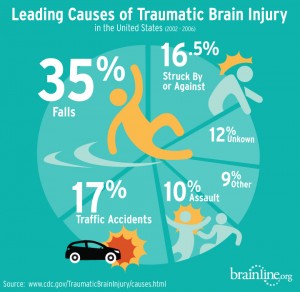As a Cincinnati car accident lawyer I see many types of injuries from car accidents. Severe traumatic brain injury is one of the most serious. It is a major medical and economic problem that is a leading cause of death in children and young adults. The current critical care management guidance is in “Guidelines for the Management of Severe Traumatic Brain Injury.”
The objectives are : prevention of intracranial hypertension, preservation of cerebral perfusion and optimization of oxygenation. Time is of the essence and early response is always essential. The most immediate thing you can do in a car crash is call 911 for help. The term golden hour is used to get the brain injured person managed medicallyas soon as possible.
Definition of Severe Traumatic Brain Injury
Severe traumatic brain injury defined as head trauma associated with a Glascgow Coma scale (GCS) score of 3-8 is a challenging problem in critical care medicine. TBI is divided into two discrete periods primary and secondary. Primary is the physical damage to the brain during the traumatic event, that causes shearing and compression of the brain tissue. Secondary brain injury is a complicated process that can include edema, hematomas, hypertension, vasospasm among others. These brain insults are mostly due to lack of blood flow and oxygen.
Causes of Traumatic Brain Injury
In the U.S., an estimated 1.7 million people sustain a traumatic brain injury (TBI) each year.
Leading causes include falls, traffic accidents, assault, and being struck by or against an object — such as another person, a wall, or a falling object. The Centers for Disease Control and Prevention report that there are:
- 595,095 fall-related TBIs
- 292,202 motor vehicle/traffic related TBIs
- 279,882 struck by/against events
- 169,625 assault-related TBIs
- 199,447 unknown causes
- 155,255 injuries classified as “other “
Acute Treatment For Severe Head Injury
There are a multitude of management techniques depending on the type of injury and the reaction of the body systems. Some of these are;
Intracranial pressure monitoring
Brain tissue Oxygen tension
Cerebral Microdialysis
Electrophysiological monitoring
Transcranial doppler Ultrsonography
Brain Temperature
Mechanical Ventilation
Nutritional support
Decompressive Craniectomy and Hemicraniectomy
This list is by no means exhaustive and is merely to show the lay person that this is a complicated process that can save lives and limit the residual effects of severe brain injury.
Predicting Outcome After TBI
A few predictive outcome models have been proposed that include age, motor score, pupillary reactivity, hypoxia, hypotension, CT classification and subarachniod hemorrage. Ask the doctor in charge of your loved one’s brain injury about these predictors. Usually once the injury victim is able to speak and comprehend a meuropsychological assessment will be performed that can inform the rehabilitation efforts in terms of cognitive functions.
Legal Help For Severe Traumatic Brain Injury Caused by Car Accidents or Other Negligence
The legal preparation for presentation of a severe traumatic brain injury entails a complete documentation of all the injuries and there are multiple experts that usually need to be consulted . Insurance adjusters will often minimize the residual affects of a brain injury and attempt to blame mood disorder, loss of focus, and other problems that affect the quality and financial future of one severely brain damaged on preexisting problems. . While it is wonderful to see a comatose patient move from coma to awareness, from inability to walk to the ability to walk without restriction, this does not mean there has been a restoration to full function by any means. You should want nothing less than complete compensation for your injury and a lawyer that knows how to portray your injury and is dedicated and capable of getting you what you deserve.
Call Anthony today for legal help for your auto accident brain or other injury at 621-2345 . Get a free case evaluation. Anthony has over 30 years experience with clients with severe car accident injuries.
Resource: Critical Care Management of Severe Traumatic brain injury in adults by Haddad and ArabiScand Journal of Trauma feb 2012
